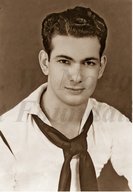
|

|
|
|
|
Philip was born in Alexandria, Louisiana, one of four children of Charles and Frances Serio. His father, a native of Italy, was a shoemaker who had a contract to repair shoes for a nearby Civilian Conservation Corps. Because he couldn't speak English, he sent Philip, then about age thirteen, back and forth to the camp. Philip also worked in his father's shop, attaching heels to shoes, while his father worked on the soles. He also earned a dollar per week changing oil in cars in a nearby garage. In his free time he played baseball and went swimming in the Red River. Philip dropped out of Bolton High School in 1937 to enlist in the U.S. Navy. After boot camp in San Diego, he was assigned to a light cruiser (he doesn't remember the name) bound for Hawaii. There he requested and was granted a three-year stint of duty in China, where he worked on a repair ship for submarines. He also served 18 months on a submarine as an electrician, 3rd class. Back in Hawaii, his tour of duty ended, he recalls his records were stamped DOW for "Duration of War." "I remember crying," he says of his disappointment. "I went down in the engine room and I cried, `I can't get out.'" He put in for a transfer to the USS Curtiss (AV-4), a seaplane tender. On December 7, 1941 he was reading a newspaper when he heard explosions. "I thought the army base was having some practice or something," he says. "I went up the hatch and just as I got up there here comes a Jap plane, `pop, pop, pop,' and just wiped out two small aircraft carriers. I knew we were at war now," he says. A bomb plummeted through the ship's hangar deck. "We had twenty-one people in the engine room and they were burned to a crisp," he says. "After it was all over with they had them laid out there: twenty-one of them with their hands in the air, just black." Philip found himself manning the switchboard that powered the ship's electrical system. "When they sounded general quarters, the electrician 1st class came down and went around and went back there in the corner behind the switchboard," Philip recalls. "He sat there with his Bible for two hours and never came out. Two hours he sat there and I had to handle that whole switchboard by myself. The ship was sinking and I had to get power to it, and pumps were still pumping water out." During the attack, sailors aboard the Curtiss spotted a Japanese mini submarine, and hit it, Philip believes, with two, five-inch guns jus as the sub released its torpedoes. Instead of slamming into the Curtiss the explosives hit an army mess hall on shore. In all, the ship suffered 78 casualties. There would have been more, Philip believes, if the ship had not berthed at Pearl City rather than at its usual place on Battleship Row. After Pearl Harbor, Philip got a 30-day leave and then orders for a sub chaser based in Boston, the SC-628, which held a 28-man crew. With a former restaurant chef as the ship's cook, he recalls eating well. When the war ended the ship put in at Portland, Oregon. "Everybody took off, including me," he recalls. "They just walked off the ship and said, `Bye.'" He went home and married Mary Terracino. Unable to find a job, he re-enlisted in New Orleans and was assigned to an oil tanker in Philadelphia, then went aboard a repair ship. He also was sent to compass school, then ordered to California to teach in a Navy electrical school. Three years into their marriage, Philip's wife passed away. After the funeral in Alexandria, he served on a destroyer in Japan, then went to a school for nuclear weaponry at Sandia Base in Albuquerque, New Mexico. He then served on aircraft carriers with nuclear weapons. Philip retired from the Navy in 1957, moved to Shreveport, and opened a liquor store. He then founded Angie's Famous Brand Shoes, a women's shoe shop, eventually owning three locations in Bossier City, Shreveport, and Monroe. He ran his shoe business for 25 years. Philip works with a local unit of the Pearl Harbor Survivors Association. He and his wife, Angelina, have two children, two grandchildren, and two great-grandchildren. |


